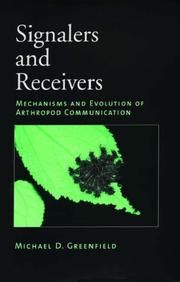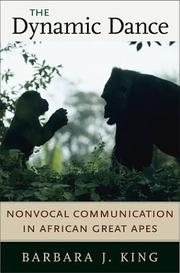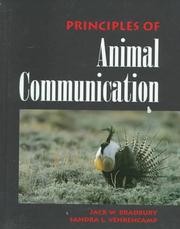| Listing 1 - 10 of 77 | << page >> |
Sort by
|
Book
ISBN: 069001659X Year: 1978 Publisher: New York (N.Y.): Crowell
Abstract | Keywords | Export | Availability | Bookmark
 Loading...
Loading...Choose an application
- Reference Manager
- EndNote
- RefWorks (Direct export to RefWorks)
Animal communication. --- Animal biocommunication --- Animal language --- Biocommunication, Animal --- Language learning by animals --- Animal behavior --- Animal communication

ISBN: 128083420X 9786610834204 0195350707 9780195350708 0195134524 9780195134520 0197702007 Year: 2002 Publisher: Oxford New York Oxford University Press
Abstract | Keywords | Export | Availability | Bookmark
 Loading...
Loading...Choose an application
- Reference Manager
- EndNote
- RefWorks (Direct export to RefWorks)
Because of their minute body size, most arthropods have problems sending and receiving acoustic and optical information. This book presents the story of how this group of animals use chemical signalling for sexual and social communication.
Arthropoda --- Animal communication. --- Animal biocommunication --- Animal language --- Biocommunication, Animal --- Language learning by animals --- Animal behavior --- Behavior.

ISBN: 0674039610 9780674039612 9780674015159 0674015150 Year: 2022 Publisher: Cambridge, MA
Abstract | Keywords | Export | Availability | Bookmark
 Loading...
Loading...Choose an application
- Reference Manager
- EndNote
- RefWorks (Direct export to RefWorks)
Mother and infant negotiate over food; two high-status males jockey for power; female kin band together to get their way. It happens among humans and it happens among our closest living relatives in the animal kingdom, the great apes of Africa. In this eye-opening book, we see precisely how such events unfold in chimpanzees, bonobos, and gorillas: through a spontaneous, mutually choreographed dance of actions, gestures, and vocalizations in which social partners create meaning and come to understand each other. Using dynamic systems theory, an approach employed to study human communication, Barbara King is able to demonstrate the genuine complexity of apes' social communication, and the extent to which their interactions generate meaning. As King describes, apes create meaning primarily through their body movements--and go well beyond conveying messages about food, mating, or predators. Readers come to know the captive apes she has observed, and others across Africa as well, and to understand "the process of creating social meaning." This new perspective not only acquaints us with our closest living relatives, but informs us about a possible pathway for the evolution of language in our own species. King's theory challenges the popular idea that human language is instinctive, with rules and abilities hardwired into our brains. Rather, The Dynamic Dance suggests, language has its roots in the gestural "building up of meaning" that was present in the ancestor we shared with the great apes, and that we continue to practice to this day.
Apes --- Animal communication --- Animal biocommunication --- Animal language --- Biocommunication, Animal --- Language learning by animals --- Animal behavior --- Behavior
Book
ISBN: 128235244X 9786612352447 0300150385 9780300150384 9780300121124 9781282352445 0300121121 9780300121148 0300121148 6612352442 Year: 2008 Publisher: New Haven Yale University Press
Abstract | Keywords | Export | Availability | Bookmark
 Loading...
Loading...Choose an application
- Reference Manager
- EndNote
- RefWorks (Direct export to RefWorks)
Dolphins have fascinated humans for millennia, giving rise to an abundance of stories and myths about them, yet the actual details of their lives in the sea have remained elusive. In this enthralling book, Kathleen M. Dudzinski and Toni Frohoff take us into the dolphins' aquatic world to witness firsthand how they live their lives, communicate, and interact with one another and with other species, including people.Kathleen M. Dudzinski and Toni Frohoff are scientists who have collectively dedicated more than 40 years to studying dolphins beneath the ocean's surface, frequently through a close-up underwater lens. Drawing on their own experiences and on up-to-the-minute research, the authors show that dolphins are decidedly not just members of a group but distinct individuals, able to communicate with one another and with humans. Dudzinski and Frohoff introduce a new way of looking at, and listening to, the vocabulary of dolphins in the sea, and they even provide an introductory "dolphin dictionary," listing complex social signals that dolphins use to share information among themselves and with people. Unveiling an intimate and scientifically accurate portrait of dolphins, this book will appeal to everyone who has wanted a closer glimpse into the hearts and minds of these amazing creatures.
Dolphins --- Animal communication. --- Animal biocommunication --- Animal language --- Biocommunication, Animal --- Language learning by animals --- Animal behavior --- Behavior.
Book
ISBN: 1527500500 9781527500501 1443881708 9781443881708 Year: 2017 Publisher: Newcastle upon Tyne, England : Cambridge Scholars Publishing,
Abstract | Keywords | Export | Availability | Bookmark
 Loading...
Loading...Choose an application
- Reference Manager
- EndNote
- RefWorks (Direct export to RefWorks)
This volume represents a short, yet systematic introduction to the topic of "animal communication", in a way that blends natural sciences and humanities into a multidisciplinary approach. It is structured in a way that allows students and teachers in this field to employ it as a useful pedagogical tool, and it is written with a style that is clear and engaging. A glossary of difficult terms and a rich bibliography are also available, altogether making Basics of Animal Communication very informative reading.
Animal communication. --- Animal biocommunication --- Animal language --- Biocommunication, Animal --- Language learning by animals --- Animal behavior --- Communication animale.
Book
ISBN: 1108131921 1108133363 1108133606 1108133843 1107280516 1108135056 1108134084 9781108135054 9781107052253 9781107280519 9781107656062 Year: 2017 Publisher: Cambridge Cambridge University Press
Abstract | Keywords | Export | Availability | Bookmark
 Loading...
Loading...Choose an application
- Reference Manager
- EndNote
- RefWorks (Direct export to RefWorks)
How do animals communicate using sounds? How did animal vocal communication arise and evolve? Exploring a new way to conceptualize animal communication, this new edition moves beyond an earlier emphasis on the role of senders in managing receiver behaviour, to examine how receivers' responses influence signalling. It demonstrates the importance of the perceiver role in driving the evolution of communication, for instance in mimicry, and thus shifts the emphasis from a linguistic to a form/function approach to communication. Covering a wide range of animals from frogs to humans, this new edition includes new sections on human prosodic elements in speech, the vocal origins of smiles and laughter and deliberately irritating sounds and is ideal for researchers and students of animal behaviour and in fields such as sensory biology, neuroscience and evolutionary biology.
Animal communication. --- Animal biocommunication --- Animal language --- Biocommunication, Animal --- Language learning by animals --- Animal behavior
Book
ISBN: 0253328551 9780253328557 Year: 1977 Publisher: Bloomington Indiana university press
Abstract | Keywords | Export | Availability | Bookmark
 Loading...
Loading...Choose an application
- Reference Manager
- EndNote
- RefWorks (Direct export to RefWorks)
Animal communication --- Communication animale --- Animal communication. --- Animal biocommunication --- Animal language --- Biocommunication, Animal --- Language learning by animals --- Animal behavior

ISBN: 0878931007 Year: 1998 Publisher: Sunderland Sinauer Associated, Inc
Abstract | Keywords | Export | Availability | Bookmark
 Loading...
Loading...Choose an application
- Reference Manager
- EndNote
- RefWorks (Direct export to RefWorks)
Animal communication. --- Communication animale --- Animal communication --- Animal biocommunication --- Animal language --- Biocommunication, Animal --- Language learning by animals --- Animal behavior
Book
ISBN: 9781107013100 1107013100 9781139003551 9781107347779 1107347777 1139003550 9781107341524 1107341523 1299403336 9781299403338 9781107345270 1107345278 110735739X 1107234875 1107348889 1107344026 9781107234871 9781107348882 9781107344020 Year: 2013 Publisher: Cambridge : Cambridge University Press,
Abstract | Keywords | Export | Availability | Bookmark
 Loading...
Loading...Choose an application
- Reference Manager
- EndNote
- RefWorks (Direct export to RefWorks)
The explanation of animal communication by means of concepts like information, meaning and reference is one of the central foundational issues in animal behaviour studies. This book explores these issues, revolving around questions such as: • What is the nature of information? • What theoretical roles does information play in animal communication studies? • Is it justified to employ these concepts in order to explain animal communication? • What is the relation between animal signals and human language? The book approaches the topic from a variety of disciplinary perspectives, including ethology, animal cognition, theoretical biology and evolutionary biology, as well as philosophy of biology and mind. A comprehensive introduction familiarises non-specialists with the field and leads on to chapters ranging from philosophical and theoretical analyses to case studies involving primates, birds and insects. The resulting survey of new and established concepts and methodologies will guide future empirical and theoretical research.
Communication animale --- Animal communication. --- Communication animale. --- Animal biocommunication --- Animal language --- Biocommunication, Animal --- Language learning by animals --- Animal behavior
Book
ISBN: 9783631737262 3631737262 3631738080 3631738072 Year: 2017 Publisher: Frankfurt am Main : Peter Lang Edition,
Abstract | Keywords | Export | Availability | Bookmark
 Loading...
Loading...Choose an application
- Reference Manager
- EndNote
- RefWorks (Direct export to RefWorks)
This book proposes a detailed picture of the continuities and ruptures between communication in primates and language in humans. It explores a diversity of perspectives on the origins of language, including a fine description of vocal communication in animals, mainly in monkeys and apes, but also in birds, the study of vocal tract anatomy and cortical control of the vocal productions in monkeys and apes, the description of combinatory structures and their social and communicative value, and the exploration of the cognitive environment in which language may have emerged from nonhuman primate vocal or gestural communication.
Animal communication. --- Language and languages --- Primates. --- Origin. --- Animal biocommunication --- Animal language --- Biocommunication, Animal --- Language learning by animals --- Animal behavior --- Origin of languages --- Speech --- Quadrumana --- Mammals --- Origin
| Listing 1 - 10 of 77 | << page >> |
Sort by
|

 Search
Search Feedback
Feedback About UniCat
About UniCat  Help
Help News
News